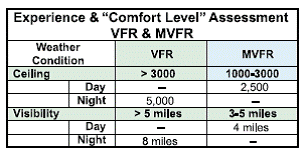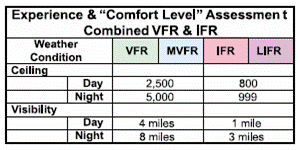|
At first glance, this part of the process might look a bit complicated, but please bear with
me. It might take a few minutes to review, record, and summarize your personal experience,
but I think you will find that the finished product is well worth your time. First, think
back through your flight training and complete the "Certification Training, and
Experience Summary" below. The Certification, Training, and Experience Summary Source
is adapted from the FAA's Personal and Weather Risk Assessment Guide (http://www.faa.gov/education_research/tr. . .%20Risk%20Assessment%20Guide-V1.0.pdf) (October 2003).

Next, think through your recent flying experiences and make a note of the lowest weather
conditions that you have comfortably experienced as a pilot in your VFR and, if applicable,
IFR flying in the last six to 12 months. You might want to use the charts below as a guide
for this assessment, but don't feel that you need to fill in every square. In fact, you may
not have, or even need, an entry for every category. For example, suppose that most of your
flying takes place in a part of the country where clear skies and visibilities of 30 plus
miles are normal. Your entry might specify the lowest VFR ceiling as 7,000, and the lowest
visibility as 15 miles. You may have never experienced MVFR conditions at all, so you would
leave those boxes blank.
In my part of the country, normal summer flying often involves hazy conditions, but over
relatively flat terrain. I know the local terrain and, since I have regularly operated in
hazy daytime MVFR conditions (e.g., 2,500 and four miles), I would use the MVFR column to
record these values. Even in my home airspace, though, I would not consider flying down to
VFR minimums at night -- much less in the range of conditions defined as MVFR. For night VFR,
I would not be comfortable with anything less than a ceiling of at least 5,000, and
visibility of at least seven to eight miles. How my entries would look in the
Experience and "Comfort Level" Asseement VFR and MFR chart:

If you fly IFR, the next part of the exercise is to record the lowest IFR conditions that you
have comfortably, recently and regularly experienced in your flying career. Again, be honest
in your assessment. Although I have successfully flown in low IFR (LIFR) conditions -- down
to a 300 foot ceiling ing and 3/4 mile visibility -- I would never claim to have been
"comfortable" in these conditions, especially since I was operating in a single
pilot/single engine configuration. I would therefore leave the LIFR boxes blank, and my
entries for known "comfort level" in Instrument Meteorological Conditions (IMC)
would be as shown below:

If I combine my entries into a single chart, the summary of my personal known "comfort
level" for VFR, MVFR, IFR, and LIFR weather conditions is as follows:

|


